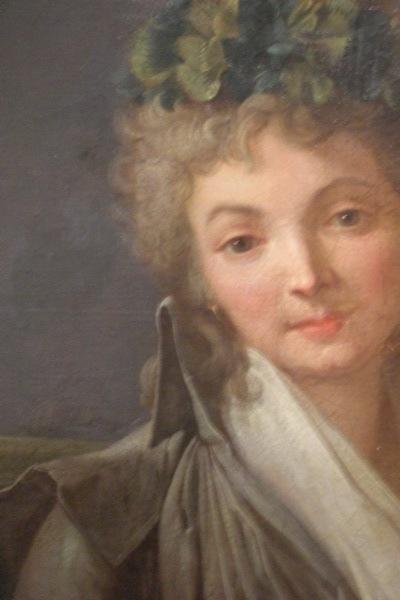
Lucile Desmoulins, Boilly, c1791. Photo: Musée Carnavalet/Melanie Clegg.
Anne Lucile Philippa Laridon-Duplessis was born in Paris in 1771 to a rich financier Étienne-Claude Duplessis-Laridon and his wife Anne-Françoise-Marie Boisdeveix. She had one elder sister, Adèle, who was widowed at an early age and then returned home to live with her parents. Lucile is known to us through her copious and highly romantic journals and was clearly an imaginative, highly strung rather mutinous girl who delighted in throwing her family into uproar by falling in love with one of her mother’s most ardent admirers Camille Desmoulins, a journalist who was ten years her senior who had money problems and a bit of a reputation for philandering.
Camille and Lucile met for the first time when she was a very young girl, while she was walking with her family in the gardens of the Palais du Luxembourg on a sunny Sunday afternoon in the early 1780s. Camille was more interested in her mother, Madame Annette Duplessis at this stage and spent a lot of time hanging around the Duplessis house at 22 Rue de Condé at this time, no doubt making something of a nuisance of himself. However, like a plot from a Mozart opera, it was Madame Duplessis’ beautiful daughter Lucile who lost her heart to him and in time he fell in love with her too, which culminated in his asking her father for her hand in marriage in 1787. He was, not entirely unsurprisingly, refused.
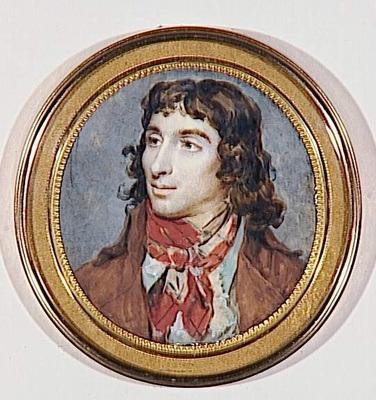
Camille Desmoulins, Dumont, 1790. Photo: Musée Carnavalet.
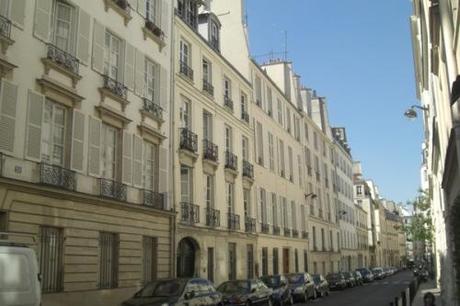

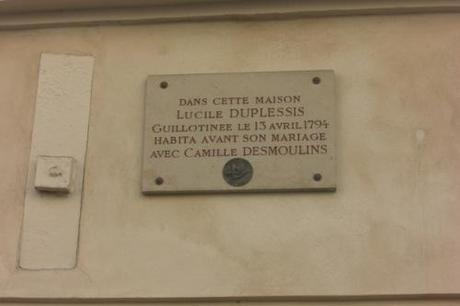
22 Rue de Condé, Paris, where Lucile grew up. There is a plaque on the house commemorating her. Photos: Melanie Clegg.
‘As to Lucile’s own feelings, it is somewhat hard to fathom them; indeed, at this time she did not know her own heart. She was scarcely more than a child, and, like many young girls, inclined to be morbid. Nevertheless, she was no fool. She had opinions and views of her own. Some of her notebooks and diaries have been preserved, and they show that she was widely read for those days and also accustomed to think for herself. Sitting up in bed, whilst her family slept, Lucile scribbled down, half furtively, her thoughts and dreams in these little exercise books. To be sure, her ideas are mainly those of her idol, Rousseau, but there is a strain of originality as well. It is when she is most coloured by her master that one likes her least.
In common with other girls, before and since, she thinks that she will never marry, she doubts her capacity for love. She is a stone, she says, cold as ice, — at the advanced age of sixteen! She imagines that she hates men, that she is a being set apart. It is not until 1789 that we begin to see the dawn of a new feeling, and even then it is only an idea which she loves. It is impossible to say when the idea materialised into the shape of shabby, fascinating Camille Desmoulins. Nevertheless, Lucile is learning that she does not hate one particular man. Later, she will know that she loves him well enough to live for him — well enough to die for him.
It is a quaint, pathetic little manuscript, that early diary of Lucile’s; a manuscript to bring a smile to the lips and tears to the eyes. So the pretty, wilful girl passed her days and nights in dreams and self-analysis, while the real romance of her life was waiting for her, close at hand, in the person of the impecunious young lawyer, who lived in such poor apartments in the Hotel Pologne.’ – Violet Methley.
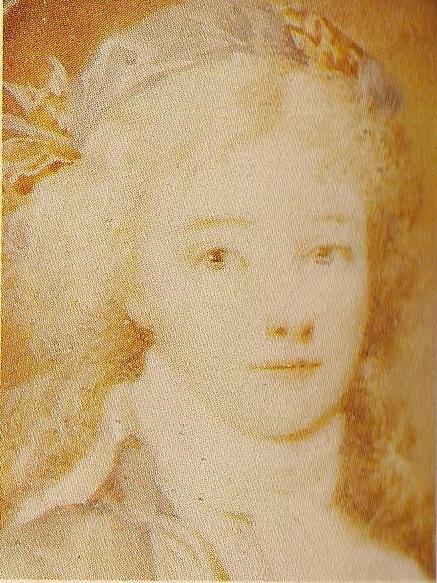
Lucile Desmoulins, unknown artist, c1790. Photo: Musée Carnavalet/Melanie Clegg.
After Camille’s infamous involvement in the fall of the Bastille which had the effect of increasing both his prestige and his fortune, Lucile’s father, who had become rather fond of his daughter’s not altogether suitable suitor, eventually gave his consent to their marriage and Camille immediately fired an ecstatic and triumphant letter off to his father in the provinces: ‘I have been waiting so long for happiness, but at last it has come, and this day sees me as happy as Mortal Man can be. Lucile, of whom I have so often written to you, and whom I have loved for eight years, has promised her hand, and her parents have finally approved. A moment ago her mother, weeping for joy, came to give me the wonderful tidings. She escorted me to her daughter’s room and I went on my knees to Lucile. Hearing her laugh, I looked up, surprised. But, like me, she was shedding tears of happiness, and she wept as she laughed. I have never seen anything so lovely.’
The couple were duly married on Christmas Eve 1790 at Saint Sulpice in Paris with the groom’s best friend Robespierre as a witness. Lucile, just twenty years old and radiantly beautiful wore a pink silk dress and garters embroidered with forget me nots and was much admired. For the groom’s part, he felt distinctly uncomfortable getting married in a church after making his loathing of organised religion so well known, but Lucile’s family insisted upon doing it ‘properly’ and he was madly in love enough to oblige them – probably feeling, to paraphrase Henri IV, that Lucile was ‘well worth a mass’.
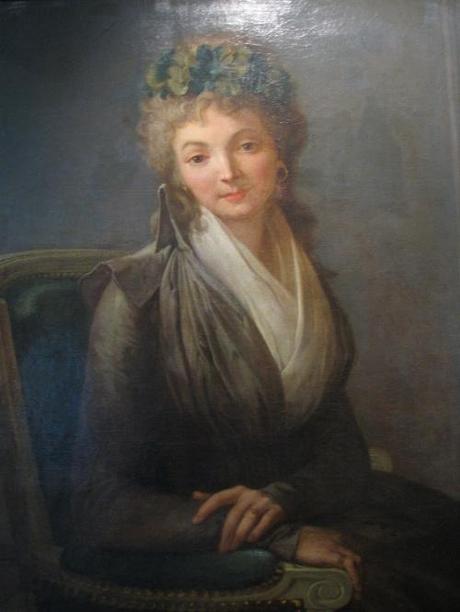
Lucile Desmoulins, Boilly, c1791. Photo: Musée Carnavalet/Melanie Clegg.
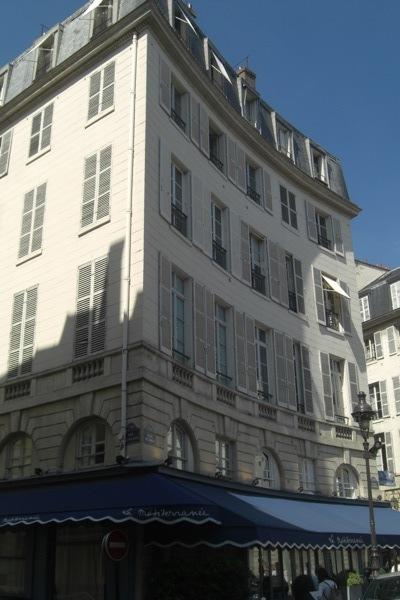
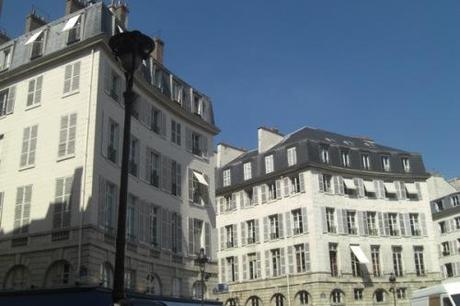
The building on the Place Odéon in Paris where Camille and Lucile lived together after their marriage and where their son, Horace was born. It’s only a few yards away from the house on the Rue de Condé where Lucile grew up. Photos: Melanie Clegg.
‘Camille had watched Lucile grow from a beautiful child into a still more beautiful girl — watched her, scarcely daring to hope that some day he might win her for his own.
Now she was twenty years old, a woman with a woman’s mind and will, in spite of her fragile and childish appearance. As to her loveliness there is no un-certainty. All the writers of that day who mention Lucile Desmoulins speak of her beauty with enthusiasm. Jules Claretie, who had himself heard her appearance described by eye-witnesses, says that ” she was of small stature, and very graceful, with beautiful fair hair, like a portrait by Greuze.”
A contemporary writer, one Moreau de Jonnes, tells us also that ‘she was an adorable little blonde’, but it appears that although her hair and complexion were strikingly fair, Lucile had dark eyes. Her own mother said of her that ‘her eyes were not blue, but black, like her father’s’.
Probably Lucile Desmoulins’ best-known portrait is that by Boilly in the Musee Carnavelet. This, and other existing pictures, certainly represent her as charmingly pretty, but, judging only by these, one might imagine that Camille’s wife was of the wax- doll type in body and mind. Nothing could be further from the truth. Lucile proved again and again that she possessed character, and character of a very distinct and definite quality. We have already seen something of what she was as a wilful, charming girl, indulged by her parents and full of immature dreams and fancies. Under the strain and stress of her bitter-sweet married life, Lucile was to develop quickly. There was a strong soul and a brave spirit in that dainty Dresden-china girl, who, at first sight, would seem to need a landscape by Watteau as her fittest frame.’ – Violet Methley.
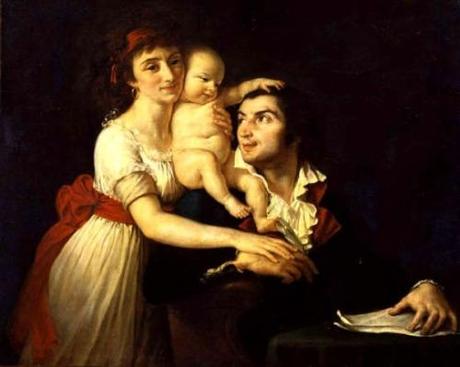
Camille and Lucile Desmoulins with their son Horace, David, 1793. Photo: Château de Versailles.
The young couple set up home on the Place de l’Odéon in the Cordeliers district of Paris and lived quite lavishly thanks to Lucile’s dowry of 100,000 francs. Their son and only child, Horace was born on the 6th of June 1792 and had Robespierre as his godfather.
Stanislas Fréron, who would later be a lover of Pauline Bonaparte, was a close friend of the couple and frequently stayed with them at their country house at Bourg-la-Reine, just outside Paris. He later left a touchingly sweet description of Lucile and it’s clear that he had a bit of a thing for her as he talks about: ‘the thyme and wild herbs with which Madame Desmoulins’ pretty dimpled hands had fed him‘ and Lucile herself ‘trotting about in her room, gliding over the polished floor, sitting for a moment at her piano, and whole hours in an easy chair, dreaming, giving the reins to her imagination, then making the coffee with a filtering bag, behaving like a sprite, and showing her teeth like a cat.’
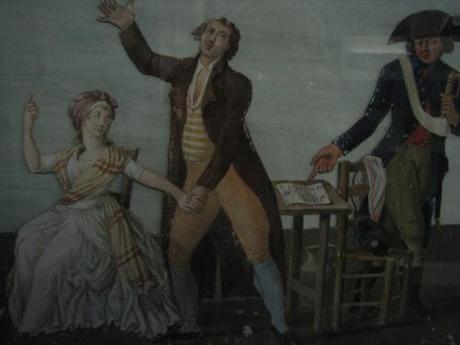
Camille and Lucile Desmoulins. Photo: Musée Carnavalet/Melanie Clegg.
In time Camille began to turn against the Terror as championed by Robespierre and his own cousins, Saint-Just and Fouquier-Tinville and sided with Danton, who dedicated himself to bringing more moderation to French politics. This was not a popular move with the Committee of Public Safety and on the 4th of April 1794, after an astonishing and dramatic trial, Danton, Desmoulins and their followers were guillotined. They were ultimately condemned by a false report, prepared and delivered by Saint-Just, that Lucile had been inciting her English and royalist friends to overthrow the revolution. Camille was distraught as he went to his death, knowing that his beloved wife, whose miniature and lock of hair he carried to the guillotine and who had gone every day with the toddler Horace to stand outside the Luxembourg prison in the hopes that he would be able to see her from a window and know that she had not forgotten him, was certain to be executed as well.
His final letter to her, written at 5am and almost illegible in places thanks to his tear stains, is heart rending in its pathos and anguish: ‘…I will dream of you one day, O Lucile! O Annette, as sensible as I was of it, death – which will deliver me from such crimes – is it so great an evil? Adieu Loulou, goodbye life, my soul, my share of divinity on earth. I leave you in the hands of good friends, and all that is virtuous and sensible! Adieu, Lucile! My dear Lucile! Adieu, Horace, Annette. Goodbye father. My life flees before my very eyes. I see once again my Lucile! I see her! My arms hold you tight! My hands bring you into my embrace! And my head, separated from my body, remains with you! I go to my death!‘
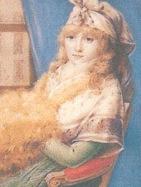
Lucile Desmoulins, possible Boilly miniature copy of an Isabey original, c1790. Photo: Musée Cognacq-Jay.
Lucile was duly arrested, separated from her two year old son, whom she entrusted to the care of her mother and sister, and executed on the 13th of April 1794, aged just twenty three and showing enormous courage at the end. Some members of the Committee were surprised that Robespierre, who had been a witness at her wedding and stood as godfather to her soon to be orphaned son, did nothing to save her despite the pleas of her family, but he dryly commented that ‘she will not want to live without Camille‘ and refused to intervene.
‘It was with more than calmness that Lucile heard that fate pronounced. She had remained perfectly serene all through the three days’ trial, quietly denying the charges of treason brought against her, yet almost dreading acquittal, so it seemed to the onlookers. When the death sentence was passed upon herself and her companions, a strange, supernatural joy shone in her eyes.
‘What happiness!’ she cried.’In a few hours I shall see my Camille again!’ And then, so it was said, a spirit of prophecy seemed to come upon the girl, as she turned to her judges. ‘In quitting this earth to which love no longer binds me,’ she said solemnly, ‘I am less to be pitied than you; for at your death, which will be infamous, you will be haunted by remorse for what you have done.’
Lucile’s strange exaltation filled her until the end. Those who saw her were amazed at her joyful bearing. Hebert’s widow (who was condemned to die alongside her) said to her with bitter self-condemnation: ‘You are lucky; nobody speaks ill of you: there is no stain on your character; you will leave life by the grand staircase.’
When Lucile apologised sweetly to Arthur Dillon (father of Madame de la Tour du Pin) for having aided to bring about his death, the gallant Irishman laughed at her self-reproach. But when he tried to find words for his own sympathy, Lucile interrupted him. ‘Look at my face,’ she said joyfully. ‘Is it that of a woman who needs to be comforted?’
She was dressed all in white, as though for a bridal, and with a white handkerchief passed over her head and tied under her chin. She seemed a very child, for she had cut off her soft, fair hair, and sent it to her mother with a little note of farewell.
As they waited for the summons to death, the girl’s courage never failed her. ‘They have assassinated the best of men,’ she said. ‘If I did not hate them for that, I should bless them for the service they have done me this day.’ She bowed to Dillon almost merrily as she ascended the tumbril; she talked sweetly and calmly to those who traveled with her along that gloomy road which led to death. Dillon no longer tried to hide his real feelings at the end. ‘Long live the King!’ he cried, as he stood upon the scaffold, and laughed at the outcry of the mob.
Of Lucile no last words are recorded. She had no thought of how her bearing would impress the by-standers, no thought at all beyond the ever-present consciousness that she was about to rejoin Camille. No faintest shadow of doubt dimmed that hope. She passed lightly up the steps of the guillotine, her ‘grand staircase’, she lay down as directed upon the plank. Her color had scarcely changed, and always she smiled — as one sees a child smile at some inward, joyful thought. Very sure it is that death had lost its sting for Lucile Desmoulins. It is even hard for us to feel the tragedy of it all, since to her it was no such thing, but a very joyous journey which should end in ‘lovers’ meetings’.
The tragedy lies here as always with those who were left, those on whom such overwhelming sorrow and loss had descended.’ – Violet Methley.
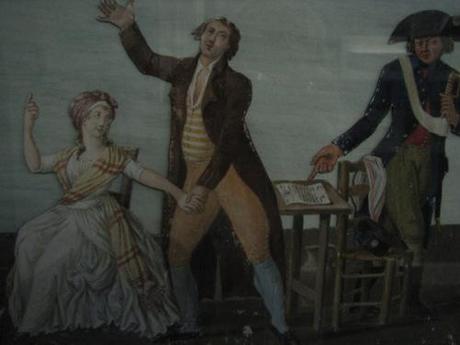
Lucile Desmoulins, unknown artist.
Her last letter, to her mother says simply: ‘Good night, dearest mother. A tear falls from my eye for you. I will go to sleep in the tranquillity of innocence. Lucile.’
******
Set against the infamous Jack the Ripper murders of autumn 1888 and based on the author’s own family history, From Whitechapel is a dark and sumptuous tale of bittersweet love, friendship, loss and redemption and is available NOW from Amazon UK and Amazon US.
‘Frothy, light hearted, gorgeous. The perfect summer read.’ Minette, my young adult novel of 17th century posh doom and intrigue is now 99p from Amazon UK and 99c from Amazon US. CHEAP AS CHIPS as we like to say in dear old Blighty.
Blood Sisters, my novel of posh doom and iniquity during the French Revolution is just a fiver (offer is UK only sorry!) right now! Just use the clicky box on my blog sidebar to order your copy!
Follow me on Instagram.
